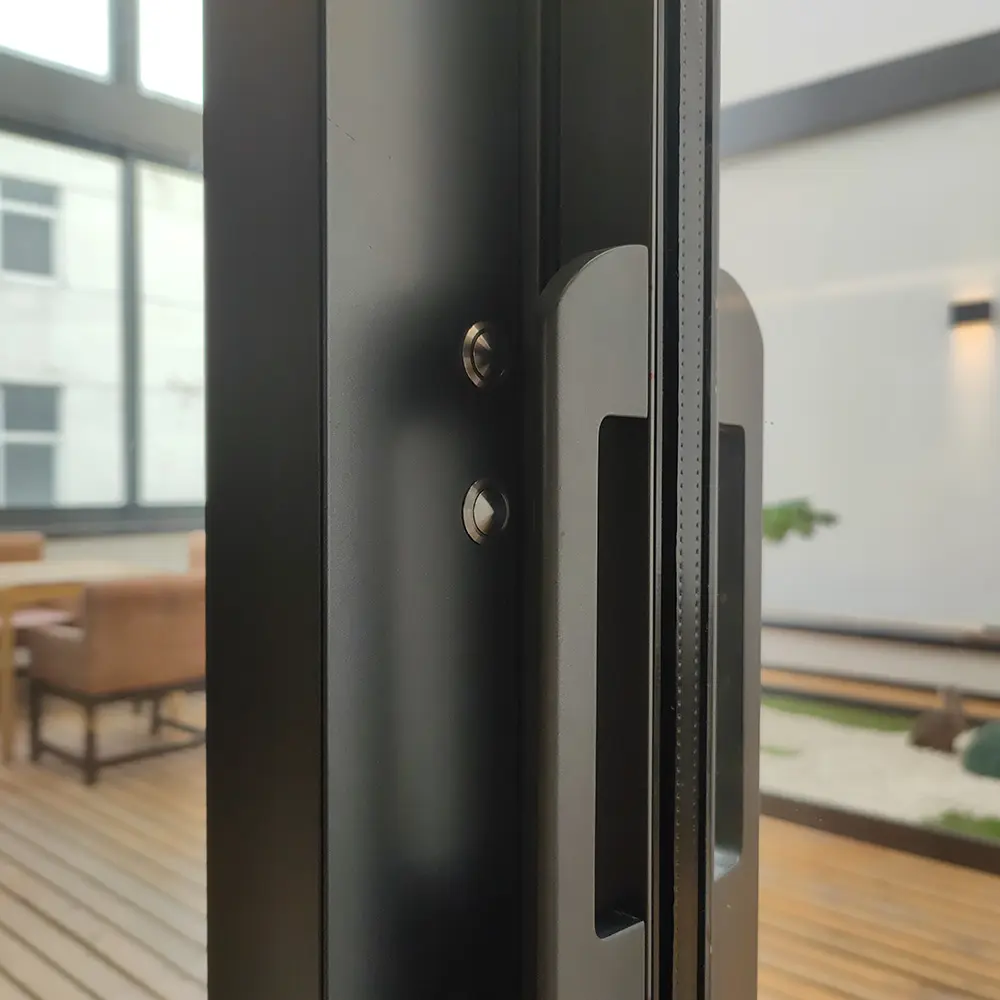보안의 미래는 출입구에서 시작된다
기술이 우리의 생활, 업무 방식과 건축 환경과의 상호작용을 재정립함에 따라 보안 시스템 역시 획기적인 변화를 겪고 있다. 이러한 진화의 가장 눈에 띄고 영향력 있는 요소 중 하나가 출입문이다. 입구 문 . 이제 단순한 물리적 장벽이 아닌 현대의 출입문은 안전성, 편리함, 디자인을 향상시키는 지능형 기능을 갖춘 동적인 인터페이스로 변모했다. 주거 공간부터 기업 본사까지, 출입문은 이제 인간과 스마트 환경 사이의 핵심 접점으로 작용하고 있다. 입구 문 . 이제 단순한 물리적 장벽이 아닌 현대의 출입문은 안전성, 편리함, 디자인을 향상시키는 지능형 기능을 갖춘 동적인 인터페이스로 변모했다. 주거 공간부터 기업 본사까지, 출입문은 이제 인간과 스마트 환경 사이의 핵심 접점으로 작용하고 있다.
출입문 기술의 진화 이해하기
기계식 잠금장치에서 지능형 접근으로
전통적인 출입문 출입문 보안을 위해 과거에는 열쇠와 단순 래치에만 의존했습니다. 시간이 지남에 따라 디드볼트나 강화된 문틀과 같은 기계적 개선으로 내구성과 안전성이 향상되었습니다. 그러나 디지털 기술의 등장은 출입문의 작동 방식을 혁신적으로 변화시켰습니다. 오늘날 많은 시스템에서는 지문 인식, 모바일 앱 제어 및 얼굴 인식 기능 등을 통합하여 전통적인 방법을 훨씬 뛰어넘는 다중 보안 기능을 제공합니다.
연결된 시스템의 부상
출입문은 점점 더 확장된 스마트 빌딩 시스템에 통합되고 있습니다. 모바일 기기, 클라우드 서비스, 자동화 플랫폼과의 연동을 통해 스마트 출입문은 이제 독립적인 장치를 넘어 네트워크 기반의 접근 제어 지점으로 진화하고 있습니다. 이러한 스마트 출입문은 출입 기록을 저장하거나 알림을 전송하며, 사용자 행동이나 환경 조건의 변화에 반응할 수 있어 보다 똑똑하고 안전한 환경을 구축하는 데 기여하고 있습니다.
스마트 출입문의 주요 기능
생체인식 및 키리스 출입 시스템
스마트 출입문에는 지문, 얼굴 인식 또는 홍채 스캔을 통해 출입할 수 있는 생체인식 스캐너가 탑재된 경우가 많습니다. 키리스 시스템은 열쇠 분실 위험과 무단 복제를 줄여줍니다. 또한 많은 출입문은 스마트폰을 통한 출입 기능을 제공하여 소유자가 원격으로 출입문을 잠그거나 열 수 있고, 출입 상황을 모니터링하거나 일시적인 출입 권한을 손님이나 서비스 제공자에게 부여할 수 있습니다.
통합 카메라 및 동작 감지 센서
고급 출입문에는 비디오 카메라와 동작 감지 센서가 장착되어 있습니다. 이러한 기능을 통해 거주자는 모니터나 모바일 기기를 통해 누가 문 앞에 있는지 실시간으로 확인할 수 있습니다. 움직임 감지는 자동 조명 작동, 경보 발령 또는 녹화 기능을 작동시켜 상황 인식을 높이고 침입자를 방지할 수 있습니다.

주거 및 상업 시설 보안 강화
주거 보안 시스템 업그레이드
스마트 출입문은 거주자에게 더 큰 통제감과 안정감을 제공합니다. 집에 있든 외출 중이든 거주자는 출입문 상태를 확인하고, 비정상적인 활동에 대한 알림을 받으며, 영상 인터컴을 통해 방문객과 소통할 수 있습니다. 가족, 고령자 또는 신체적 제약이 있는 개인에게 이러한 시스템은 접근성과 추가적인 보안을 제공합니다.
상업용 출입 통제 솔루션
상업 시설에서 스마트 출입문은 직원의 안전과 자산 보호를 위한 첫 번째 방어선 역할을 합니다. 출입 권한을 중앙에서 관리할 수 있어 관리자는 권한을 부여하고, 출입 기록을 추적하며, 민감한 구역에 대한 접근을 제한할 수 있습니다. 이러한 출입문 시스템은 건물 관리 시스템과 통합되어 운영을 효율화하고 보안 프로토콜을 강화합니다.
디자인과 미적 통합
건축 조화 유지
스마트 출입문은 기술적으로 복잡하더라도 건물의 건축 양식에 맞춰 설계될 수 있습니다. 금속, 유리 및 목재와 같은 소재를 고급 기능과 결합하여 보안성과 미관을 동시에 갖춘 출입문을 제작할 수 있습니다. 매끄러운 마감 처리, 숨겨진 하드웨어 및 최소한의 디자인은 스마트 기능이 미적 가치를 해치지 않도록 보장합니다.
맞춤화 및 브랜딩
상업 공간은 브랜드 정체성을 반영하는 맞춤형 출입문을 적용함으로써 많은 이점을 얻을 수 있습니다. 로고, 패턴, 색상 조합 등을 출입문 디자인에 반영할 수 있습니다. 주거 공간에서는 개인화된 스마트 출입문에 독특한 손잡이, 장식용 유리 패널 또는 주택 소유자의 취향에 맞는 마감 처리를 적용할 수 있습니다.
에너지 효율성 및 지속 가능성
단열 및 스마트 클라이언트 제어
현대식 현관문은 에너지 효율성을 고려해 설계됩니다. 단열 코어, 방풍 스트립 및 에너지 효율 등급의 유리는 실내 온도 유지에 도움을 줍니다. 스마트 현관문이 빌딩의 냉난방 시스템과 연동되었을 경우, 문이 열리거나 닫힐 때 난방 또는 냉방 장치를 자동으로 작동시켜 건물의 종합적인 에너지 관리 전략을 지원할 수 있습니다.
지속 가능한 소재 및 친환경 제조
현관문 제작에는 지속 가능한 생산 방식이 점점 더 보편화되고 있습니다. 재활용 금속, FSC 인증 목재, 저배출 코팅제 등을 사용하면 환경 영향을 줄일 수 있습니다. 친환경 소재로 만들어진 스마트 현관문을 선택하면 친환경 건축 접근법에 기여할 수 있으며 기업 또는 개인의 지속 가능성 목표와도 부합됩니다.
사용자 편의성 및 원격 제어
모바일 접근 및 원격 모니터링
스마트 출입문은 스마트폰이나 다른 디지털 기기를 통해 출입을 제어할 수 있어 편리함을 제공합니다. 주택 소유자는 직장에 있을 때 손님을 들여보낼 수 있고, 건물 관리자는 실시간으로 출입 내역을 모니터링할 수 있습니다. 일부 출입문 시스템은 음성 명령 기능과 호환되어 가상 어시스턴트와 연동되기도 합니다.
예약된 출입 권한 및 일시적 출입 권한
주택용 및 상업용 공간 모두에서 택배 기사, 관리 인력 또는 손님과 같은 일시적인 출입이 필요한 경우가 많습니다. 스마트 출입문은 시간 제한이 있는 출입을 설정할 수 있어 일상적인 운영을 지원하면서도 보안을 유지할 수 있습니다. 출입 기록과 만료 타이머는 책임성과 통제력을 높여줍니다.
안전 및 응급 기능
비상 잠금 기능
일부 스마트 출입문에는 위협이나 비상 상황 시 활성화할 수 있는 잠금 기능이 제공됩니다. 이 기능은 신속한 보안 대응이 중요한 학교, 사무실 및 정부 건물에서 특히 유용합니다. 비상 우회 시스템은 정전이나 화재 경보 시 수동으로 출구를 사용할 수 있게 해줍니다.
화재 및 날씨 저항성
디지털 지능과 별도로 물리적인 견고성은 여전히 중요한 요소입니다. 스마트 출입문은 내화 등급 인증 및 충격 저항 재질로 제작된 제품도 있습니다. 이러한 특성은 자연재해에 취약한 지역이나 엄격한 안전 규정을 요구하는 상업용 건물에서 특히 중요합니다.
I 설치 및 시스템 통합
기존 인프라와 호환성
모든 건물이 신축되는 것은 아니므로 리트로핏이 가능한 스마트 입구 도어에 대한 수요가 증가하고 있습니다. 많은 시스템은 기존 도어 프레임, 전기 배선 및 보안 시스템과 통합되도록 설계되었습니다. 이러한 적응성 덕분에 전체 리모델링 없이도 쉽게 업그레이드할 수 있습니다.
시스템 동기화
스마트 출입문은 건물 관리 또는 자동화 시스템과 완전히 동기화될 때 가장 효과적으로 작동합니다. 조명, HVAC, 감시 및 경보 시스템을 중앙 집중식 플랫폼을 통해 연결할 수 있습니다. 제대로 설치되고 설정된 경우, 출입문은 보다 큰 스마트 생태계의 자연스러운 일부가 됩니다.
유지 관리 및 수명
시스템 업데이트 및 기술 지원
지속적인 소프트웨어 업데이트를 통해 스마트 출입문이 안전하고 기능적으로 유지되도록 보장합니다. 많은 제조사에서 정기적인 펌웨어 개선, 기술 지원 및 문제 해결 서비스를 제공합니다. 클라우드 기반 플랫폼을 통해 물리적 개입 없이도 업데이트가 가능하여 다운타임을 최소화할 수 있습니다.
재료 및 전자장비의 내구성
스마트 출입문은 고속 통행 지역에서 장기간 사용하도록 설계되었습니다. 강화 강철, 알루미늄, 강화 유리와 같은 재료는 마모와 풍화에 강합니다. 내부 전자장비는 방수 또는 방진 케이스에 장착되어 다양한 환경 조건에서도 신뢰성을 유지합니다.
올바른 투자 결정하기
비용 대비 장기적 가치
스마트 출입문은 초기 투자 비용이 일반 출입문에 비해 높을 수 있지만, 장기적인 가치는 매우 큽니다. 이 시스템은 에너지 비용 절감, 보안성 향상, 접근성 개선 및 부동산 가치 증대 등의 혜택을 제공합니다. 전체 수명 주기를 고려할 때 운영 효율성과 유지보수 비용 절감을 통해 대부분의 경우 초기 투자 비용을 상쇄할 수 있습니다.
공급업체 전문성과 제품 지원 평가
성공적인 구현을 위해서는 올바른 공급업체를 선택하는 것이 중요합니다. 보증, 설치 서비스, 사후 지원을 제공하는 업체를 찾아야 합니다. 신뢰할 수 있는 파트너는 제품 선택, 시스템 통합 및 운영 관리 전반에 걸쳐 안내하여 스마트 출입문이 모든 성능 및 안전 기준을 충족하도록 보장할 수 있습니다.
자주 묻는 질문
스마트 출입문과 일반 출입문의 차이점은 무엇인가요?
스마트 출입문은 키리스(Keyless) 출입, 생체 인식 기술, 원격 제어 기능 등의 기술을 적용하여 일반 출입문에 비해 보안성과 편의성을 크게 향상시킨 제품입니다.
스마트 출입문을 커스터마이징할 수 있나요?
네, 스마트 출입문은 재질, 디자인, 색상 및 기능 등 여러 측면에서 주거용 및 상업용 공간에 맞게 맞춤 제작할 수 있습니다.
스마트 출입문은 오래된 건물과도 호환되나요?
많은 스마트 출입문 시스템은 기존 건물에 retrofit(개조) 설치할 수 있도록 설계되어 있으며, 대대적인 리모델링 없이 기존 인프라와 통합할 수 있습니다.
스마트 출입문에는 정기적인 유지보수가 필요한가요?
스마트 출입문은 최상의 성능을 위해 주기적인 소프트웨어 업데이트와 가끔씩 하드웨어 점검이 필요하지만, 일반적으로 유지보수가 거의 필요한 없는 시스템입니다.

